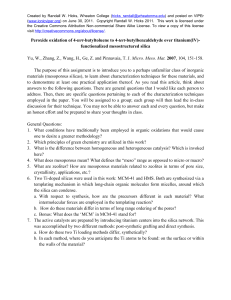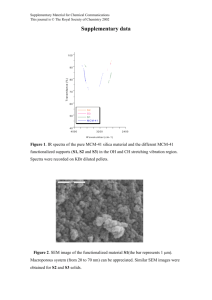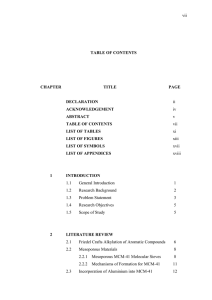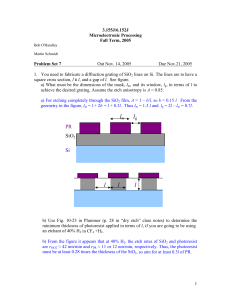viii TITLE DECLARATION
advertisement
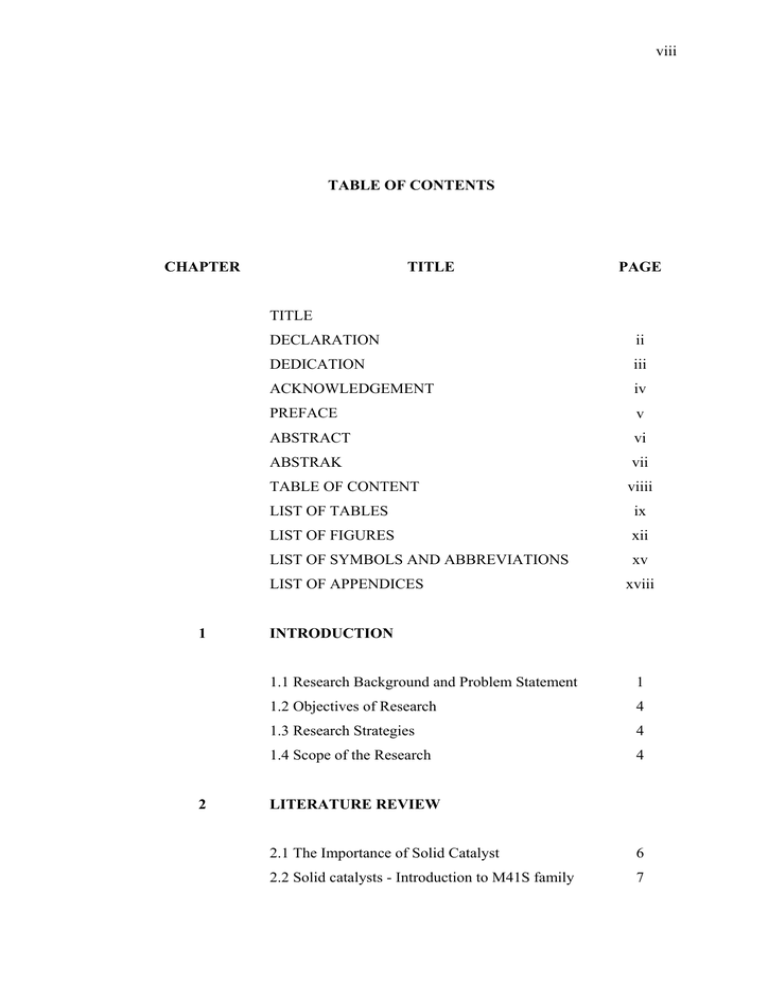
viii TABLE OF CONTENTS CHAPTER TITLE PAGE TITLE DECLARATION ii DEDICATION iii ACKNOWLEDGEMENT iv PREFACE v ABSTRACT vi ABSTRAK vii TABLE OF CONTENT viiii LIST OF TABLES ix LIST OF FIGURES xii LIST OF SYMBOLS AND ABBREVIATIONS xv LIST OF APPENDICES 1 2 xviii INTRODUCTION 1.1 Research Background and Problem Statement 1 1.2 Objectives of Research 4 1.3 Research Strategies 4 1.4 Scope of the Research 4 LITERATURE REVIEW 2.1 The Importance of Solid Catalyst 6 2.2 Solid catalysts - Introduction to M41S family 7 ix 2.3 Generation of Active Sites in AlMCM-41 Mesoporous Materials 3 10 2.4 Generation of acid sites via sulphation 12 2.5 Friedel-Crafts Reactions and Solid Catalysts 14 EXPERIMENTAL 3.1 Starting Materials 15 3.2 Preparation of AlMCM-41 15 3.3 Preparation of Protonated MCM-41 16 (H-AlMCM-41) 3.4 Synthesis of Sulphated AlMCM-41 17 3.5 Characterization of MCM-41 Materials 17 3.5.1 X-ray Powder Diffraction (XRD) 17 3.5.2 Fourier Transform Infrared Spectroscopy (FTIR) 18 3.5.3 Solid State Magic Angle Spinning Nuclear Magnetic Resonance (MAS NMR) Spectroscopy 19 3.5.4 Thermogravimetric and Differential Thermal Analysis (TG-DTA) 21 3.5.5 Nitrogen Adsorption-Desorption Isotherm Analysis 22 3.5.6 Fourier Transform Infrared Spectroscopy of Pyridine Adsorption 3.5.7 Hammett Acidity Analysis 3.6 Dibenzoylation of Biphenyl Reaction over 23 26 26 Sulphated AlMCM-41 3.6.1 Dibenzoylation of Biphenyl Reaction over Various Types of Catalysts 28 3.6.2 Synthesis of 4-PBP as authentic sample 28 3.6.3 Synthesis of 4, 4’-DBBP as authentic Sample 29 x 3.6.4 Calibration Curve for Authentic Sample 4 29 RESULTS AND DISCUSSION 4.1 X-Ray Diffraction Analysis 32 4.2 Infrared Spectroscopy of AlMCM-41 Molecular Sieves 36 4.3 Nitrogen Adsorption Measurement 38 4.4 Thermal Analysis 40 27 4.5 Solid State Al MAS NMR 29 43 4.6 Solid State Si MAS NMR 47 4.7 Acidity Measurements 49 4.7.1 Pyridine-FTIR Spectroscopy 49 4.7.2 Hammett indication Analysis 53 4.8 Catalytic testing: Dibenzoylation of Biphenyl 55 4.8.1 Effect of Catalyst 55 4.8.2 Effect of SiO2/Al2O3 ratio 58 4.8.3 Reaction Temperature 59 4.8.4 Effect of Catalyst Loading 60 4.8.5 Effect of Benzoyl Chloride : Biphenyl Mole Ratio 4.9 Mechanism 62 63 4.10 Mass balance of Dibenzoylation of Biphenyl with Benzoyl Chloride 4.11 Proposed Structure 5 66 68 CONCLUSIONS 5.1 Conclusions 69 REFERENCES 71 APPENDICES 77 xi LIST OF TABLES NO. TABLE TITLE PAGES 2.1 Comparison of the various phases of catalysts. 7 3.1 Amount of NaAlO2 added in preparing AlMCM-41. 16 3.2 The organic compounds used as Hammett Indicators. 26 3.3 GC-FID oven-programmed setup for identifying 4, 4’-DBBP. 27 3.4 GC-MSD oven-programmed setup for identifying 4, 4’-DBBP. 28 4.1 XRD data of various MCM-41 samples. 33 4.2 The textural properties of various protonated and sulphated 39 MCM-41 samples obtained form calculation and surface analyzer. 4.3 Peak areas of octahedral aluminium (Aloct) and tetrahedral 45 aluminium (Altet) from 27Al MAS NMR spectra 4.4 Peak areas of octahedral aluminium species in aluminium 45 sulphate (AlAl2(SO4)3) and sulphated AlMCM-41 (AlSulphated AlMCM-41) from 27Al MAS NMR spectra. 4.5 Peak areas of silicon species in SCAL-4 48 4.6 Pyridine FTIR data of protonated and sulphated MCM-41 52 materials. 4.7 The results of acid strength of catalysts using Hammett 54 indicators. 4.8 Benzoylation and dibenzoylation of biphenyl with benzoyl 57 chloride over various types of catalysts at 180 oC for 24 h. 4.9 Amount of Brönsted acid active sites in SCAL-4 with different 61 loading and and its effect towards conversion of biphenyl. 4.10 Theoretical mass balance 67 4.11 Experimental mass balance 67 xii LIST OF FIGURES NO. FIGURE 1.1 TITLE Two proposed reaction routes: (Route1) direct and (Route 2) PAGES 3 consecutive synthesis of the dibenzoylation of biphenyl using sulphated AlMCM-41 mesoporous materials and benzoyl chloride. 1.2 Flow diagram of research strategies. 5 2.1 Illustration of hexagonal honeycomb structure of mesoporous 9 MCM-41 with 2 nm to 10 nm pore size. 2.2 Formation of MCM-41 materials. (a) Coagulation of surfactants 9 process, (b) Combination of organic and inorganic materials, (c) MCM-41. 2.3 Framework of (a) SiMCM-41 and (b) AlMCM-41. 10 2.4 Generation of Brönsted acid sites. 11 2.5 Generation of Lewis acid sites. 12 2.6 Benzoylation of an aromatic compound using aluminium 13 trichloride as catalyst, leading to a stable Lewis complex. 2.7 Friedel-Crafts acylation showing a typical starting materials, 14 products and waste mass balance. 3.1 Range of 29Si chemical shifts of Qn in solid silicate. 21 3.2 Proposed mechanism of interaction between pyridine molecules 24 with (a) Brönsted and (b) Lewis acid sites in MCM-41 molecular sieves. 3.3 Adsorption and desorption of pyridine apparatus for acidity study. 25 3.4 Quantitative calibration plot of biphenyl. 30 3.5 Quantitative calibration plot of 4-PBP. 30 3.6 Quantitative calibration plot of 4, 4’-DBBP. 31 xiii 4.1 X-ray diffractogram patterns of uncalcined mesoporous MCM-41 34 molecular sieves. (a) UNCAL-1, (b) UNCAL-2, (c) UNCAL-3 and (d) UNCAL-4. 4.2 X-ray diffractogram patterns of mesoporous MCM-41 materials 34 after calcinations at 550 oC for 10 h. (a) CAL-1, (b) CAL-2, (c) CAL-3 and (d) CAL-4. 4.3 X-ray diffractogram patterns of protonated MCM-41 materials 35 o after ion exchange with NH4NO3 and calcination at 500 C (a) HCAL-1, (b) HCAL-2, (c) HCAL-3 and (d) HCAL-4. 4.4 X-ray diffractogram patterns of sulphated MCM-41 materials (a) 35 SCAL-1, (b) SCAL-2, (c) SCAL-3 and (d) SCAL-4. 4.5 FTIR spectra of uncalcined mesoporous MCM-41 molecular 37 sieves. 4.6 FTIR spectra of calcined mesoporous MCM-41 molecular sieves. 37 4.7 FTIR spectra of sulphated mesoporous MCM-41 molecular sieves. 38 4.8 Modification of surface of MCM-41 through sulphation leads to 39 shrinkage of pore diameter. 4.9 Thermogravimetric analysis of uncalcined MCM-41 sample 40 (UNCAL-2) in nitrogen gas with 20 oC/min heating rate. 4.10 Thermogravimetric analysis of uncalcined MCM-41 samples with 41 various ratio of SiO2/Al2O3. 4.11 Thermograms of a series of protonated MCM-41 molecular sieves. 42 4.12 Thermogravimetric curves of sulphated AlMCM-41 materials. 43 4.13 27 44 Al NMR spectra of protonated MCM-41 molecular sieves (a) HCAL-4, (b) HCAL-3, (c) HCAL-2 and (d) HCAL-1. 4.14 27 Al NMR spectra of sulphated MCM-41 molecular sieves (a) 44 SCAL-4, (b) SCAL-3, (c) SCAL-2 and (d) SCAL-1. 4.15 29 Si NMR spectrum of sulphated MCM-41 molecular sieves 48 (SCAL-4). 4.16 The possible silicon species and Brönsted acid sites in sulphated 49 AlMCM-41. 4.17 The pyridine-FTIR spectra of purely siliceous sulphated MCM-41 (SCAL-1) at (a) room temperature, (b) 150 oC, (c) 250 oC and (d) 50 xiv 350 oC. 4.18 The pyridine-FTIR spectra of sulphated AlMCM-41 (SCAL-2) at o o 51 o (a) room temperature, (b) 150 C, (c) 250 C and (d) 350 C . 4.19 The pyridine-FTIR spectra of sulphated AlMCM-41 (SCAL-3) at 51 (a) room temperature, (b) 150 oC, (c) 250 oC and (d) 350 oC . 4.20 The pyridine-FTIR spectra of sulphated AlMCM-41 (SCAL-4) at 52 (a) room temperature, (b) 150 oC, (c) 250 oC and (d) 350 oC . 4.21 FTIR spectra of silanol groups of MCM-41 materials at 250 oC (a) 53 before treatment (HCAL-1) and (b) after treatment (SCAL-1) of sulphuric acid. 4.22 Dibenzoylation of biphenyl catalyzed by various types of catalysts 57 4.23 Conversion of biphenyl over various ratio of SiO2/Al2O3 within 24 58 h. 4.24 Yield of 4, 4’-DBBP over various ratio of SiO2/Al2O3 within 24 h. 59 4.25 Temperature effect towards dibenzoylation of biphenyl over 60 SCAL-4. 4.26 Effect of catalyst loading towards dibenzoylation of biphenyl over 61 SCAL-4. 4.27 Effect of Biphenyl : Benzoyl Chloride molar ratio towards 62 dibenzoylation of biphenyl over SCAL-4. 4.28 Mechanism of how the electron density affects BP and 4-PBP in 63 attacking benzoylium ion. 4.29 Formation of 4-phenyl benzophenone (4-PBP) via electrophilic 64 substitution. 4.30 Mechanism of production of 4, 4’-dibenzoyl biphenyl (4, 4’- 65 DBBP). 4.31 Stoichiometrical chemical equation of dibenzoylation of biphenyl 66 reaction. 4.32 Hydrolysis of benzoyl chloride as side reaction in production of 68 benzoic acid and benzoic anhydrice. 4.33 Scheme proposed for the sulphated AlMCM-41 materials showing possible Brönsted acid sites. 68 xv LIST OF SYMBOL AND ABBREVIATIONS MCM-41 - Mobile Crystalline Material-41 RHA - Rice husk ash Py - Pyridine i.e. - Id est (that is) BET - Brunauer-Emmett-Teller GC - Gas chromatography Å - Angstrom (10-10 meters) kV - Kilovolts α - Alpha β - Beta PDPV - Poly (4, 4’-diphenylene diphenylvinylene) LED - Light emitting devices IUPAC - International Union of Pure Applied Chemistry LCT - Liquid-crystal templating n - Diffraction order from n = 1, 2, 3, …. d - Distance 2D - Two dimensions λ - Lambda θ - Theta δ - Delta FTIR - Fourier transform infrared NMR - Nuclear magnetic resonance MAS - Magic angle spinning CP - Cross polarization EFAL - Extra-framework aluminium ppm - Part per million xvi % - Percent ~ - Approximately TG/DTA - Thermogravimetric and Differential Thermal Analysis TGA - Thermogravimetric Analysis DTA - Differential Thermal Analysis Ho - Hammett acidity function µL - Microlitre MS - Mass spectrometry GC-MS - Gas chromatography combined with spectrometry 4-PBP - 4-Phenyl benzophenone 4, 4’-DBBP - 4, 4’-dibenzoylbiphenyl CTABr - Cetyltrimethylammonium bromide NH4OH - Ammonium hydroxide min - Minute o - Celsius h - Hour wt% - Weight percent g - Gram mg - milligram SiO2/Al2O3 - Silica over alumina ratio mol - Mole mmol - Millimole m.p. - Melting point mA - Milliampere o - Degree cm-1 - Per centimeter UNCAL-1 - Uncalcined MCM-41 with SiO2/Al2O3 ratio ∞ UNCAL-2 - Uncalcined AlMCM-41 with SiO2/Al2O3 ratio 60 UNCAL-3 - Uncalcined AlMCM-41 with SiO2/Al2O3 ratio 30 UNCAL-4 - Uncalcined AlMCM-41 with SiO2/Al2O3 ratio 15 CAL-1 - Calcined MCM-41 with SiO2/Al2O3 ratio ∞ CAL-2 - Calcined AlMCM-41 with SiO2/Al2O3 ratio 60 C mass xvii CAL-3 - Calcined AlMCM-41 with SiO2/Al2O3 ratio 30 CAL-4 - Calcined AlMCM-41 with SiO2/Al2O3 ratio 15 HCAL-1 - Protonated MCM-41 with SiO2/Al2O3 ratio ∞ HCAL-2 - Protonated AlMCM-41 with SiO2/Al2O3 ratio 60 HCAL-3 - Protonated AlMCM-41 with SiO2/Al2O3 ratio 30 HCAL-4 - Protonated AlMCM-41 with SiO2/Al2O3 ratio 15 SCAL-1 - Sulphated MCM-41 with SiO2/Al2O3 ratio ∞ SCAL-2 - Sulphated AlMCM-41 with SiO2/Al2O3 ratio 60 SCAL-3 - Sulphated AlMCM-41 with SiO2/Al2O3 ratio 30 SCAL-4 - Sulphated AlMCM-41 with SiO2/Al2O3 ratio 15 MHz - Megahertz µs - Microsecond TMS - Tetramethyl silane BJH - Barrett, Joyner, Halenda mbar - millibar kPa - Kilopascal m/z - Mass over charge ao - Unit cell parameters t - Crystallite size Wd - Pore diameter bd - Pore wall thickness xviii LIST OF APPENDICES APPENDICES A TITLE PAGES Calculation of the amount of pyridine adsorbed on the sample in 77 the acidity study of sulphated AlMCM-41 samples. B Infrared spectrum of 4-phenyl benzophenone (4-PBP). 78 C Mass spectrum of 4-phenyl benzophenone (4-PBP). 79 D Infrared spectrum of 4, 4’-dibenzoyl biphenyl (4, 4’-DBBP). 80 E Mass spectrum of 4, 4’-dibenzoyl biphenyl (4, 4’-DBBP). 81 F Calculation of % conversion and % selectivity. 82 G The pyridine-FTIR spectra of HCAL-1 at (a) room temperature, 83 o o o (b) 150 C, (c) 250 C and (d) 350 C. H The pyridine-FTIR spectra of HCAL-2 at (a) room temperature, 84 (b) 150 oC, (c) 250 oC and (d) 350 oC. I The pyridine-FTIR spectra of HCAL-3 at (a) room temperature, 85 (b) 150 oC, (c) 250 oC and (d) 350 oC. J The pyridine-FTIR spectra of HCAL-4 at (a) room temperature, o o 86 o (b) 150 C, (c) 250 C and (d) 350 C. K Chromatogram of reactants at 0 h. 87 L Chromatogram of reactants and products. 88 M Data obtained from GC-FID Chromatograms (Friedel-Crafts 89 dibenzoylation of biphenyl with benzoyl chloride over SCAL-4). N Mass balance of dibenzoylation of biphenyl with benzoyl 90 chloride (Experimental) O Mass balance of dibenzoylation of biphenyl with benzoyl chloride (Theoretical) 98
